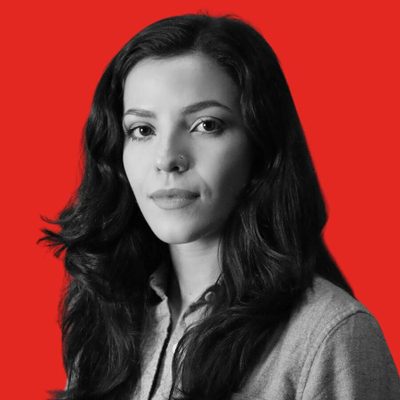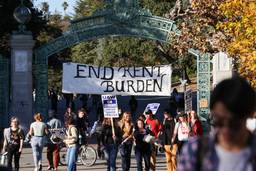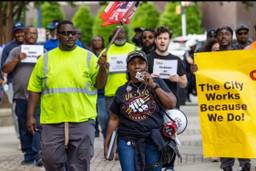
The uprisings following the Minneapolis police killing of George Floyd, a 46-year-old unarmed Black man, have articulated a clear demand: defund the police. Under pressure from students, communities and teachers’ unions, schools have been at the forefront of changes, by ending millions of dollars worth of contracts between public schools and police departments.
In this struggle, teachers unions have been organizing critical support for the movement, which is largely led by Black and Brown youth. Among them is the Chicago Teachers Union, which has been organizing rallies, mobilizing members, releasing statements of solidarity and contributing to a vision for what police-free Chicago schools could look like. In many cases, teachers are following the lead of their students, taking to the streets because youth are demanding profound change. Fresh off of a 2019 strike in which the union placed social justice demands front and center, CTU is showcasing how to mobilize for the common good during a time of social upheaval.
The demand to remove school resource officers (SROs) is not new, and extends far beyond the CTU: It has been made by students, parents, teachers, community organizations and civil rights advocates alike for years due to the primary role SROs play in funneling students into a school-to-prison pipeline which overwhelmingly targets Black students and students of color, often for non-criminal behavior. The ACLU found in a 2019 report that under “Zero-tolerance” policies which “criminalize minor infractions of school rules,” Black students are suspended or expelled three times more than white students and are “nearly three times more likely to be in contact with the juvenile justice system the following year.” The ACLU report also found that, nationwide, “14 million students are in schools with police but no counselor, nurse, psychologist, or social worker.”
#CopsOutCPS is a coalition of community groups, including Assata’s Daughters and Brighton Park Neighborhood Council, fighting to dismantle the school-to-prison pipeline. A new report from the coalition shows just how stark this reality is within Chicago Public Schools (CPS). Drawing on data from Freedom of Information Act requests to both CPS and the Chicago Police Department (CPD), the report found that Black students are four times more likely to be targeted by police than white students. Overall, 95% of police incidents in Chicago schools involved students of color, the report finds.
Though the bulk of school-based police incidents is concentrated among students aged 15 to 18, students as young as six have been the target of CPD action, according to the report. And Black women and girls (binary language that the report acknowledges as insufficient) experience school-based policing seven times more than their white counterparts. The investigation reveals that a combined total of 2,354 misconduct complaints had been filed against the 180 SROs and 21 School Liaison Supervisors working throughout CPS. The report’s ultimate conclusion: “Policing puts Black students and students of color in danger.”
Demands to remove school police – – or in the case of Los Angeles, which has its own independent police force – – to disband school police units entirely, have gained new force amid the nationwide uprising. Minneapolis, Portland, Denver and Charlottesville, Va., have all severed ties with police in under two weeks, with at least a dozen other school districts facing demands to do the same. In Chicago, Seattle, Los Angeles, Boston, Oakland, Richmond, Calif., Tacoma, Wash., Madison, Wisc., and Racine, Wisc., teachers unions have taken a proactive role in calling on their school boards to follow suit. This demand also reflects a demand from the Movement for Black Lives and #8toAbolition, a campaign that aims to build a society where police and prisons are not necessary.
Chicago and Los Angeles, where students of color make up around 90% of the student population in each school district, have been among the two most vocal cities in the fight to defund the police. The Chicago Teachers Union (CTU) and United Teachers Los Angeles (UTLA) both went on strike in 2019 when their contracts expired, and brought demands from the wider community, like affordable housing and support for immigrant families, to their contract negotiations in an approach called bargaining for the common good. While contracts are not currently up for negotiation, both unions are engaging in the same social justice framework in making these demands with fellow students, parents and community organizations.
On June 4, rank-and-file CTU members joined a CPS community protest to demand justice for George Floyd and call for the city to defund the police. CTU President Jesse Sharkey released a statement that same day calling on the city of Chicago to follow the examples set by others to terminate the school district’s police contract and cut the city’s police budget more broadly. “Students see themselves and their friends in the desperate pleas of George Floyd. They know that any one of them could be subject to that kind of extrajudicial lynching — even in their schools,” Sharkey said in the statement.
CTU and a number of community groups organized a caravan protest two days later reaffirming these demands and calling on the city to invest money from the police budget into restorative practices, social workers and student support staff in schools.
“It’s not defund the police in absence of everything else,” says Jenine Wehbeh who teaches 7th and 8th grade social studies in Chicago’s John B. Murphy Elementary School. “It’s actually investing in the things that the community needs and our school buildings need in order to not need police, not need a military-level of intervention.”
The harrowing absurdity of sending armed police into under-funded schools was the subject of recent outrage over a resurfaced 2014 L.A. Times report about how the city’s school police, which was receiving military weaponry through a federal program to local law enforcement, would “return three grenade launchers but intend[ed] to keep 61 rifles and a Mine Resistant Ambush Protected armored vehicle it received through the program.” With so many schools starved for resources, many unions have articulated a consistent demand to directly reinvest the money cut from cities’ bloated police budgets into nurses, counselors, social workers, and, in many cases, restorative justice programs for schools.
Before becoming a teacher, Wehbeh organized around dismantling the school-to-prison pipeline at the national level. In addition to teaching social studies she also runs the peer mediation program at her school, a restorative justice tool where students are trained in a conflict-resolution process that does not involve police. Part of CTU’s 2019 contract negotiation included funding for 30 new positions a year at CPS schools, most of which have opted for restorative justice coordinators. Within CTU, a safety committee consisting of rank-and-file members works with restorative justice coaches and training staff, but with resources stretched thin, Wehbeh says many times the staff members engaging in restorative justice practices juggle multiple roles as teachers or counselors.
In a city where nearly 40% of the general operating budget is already diverted to police departments, the school board approved of a $33 million contract last summer — approximately $90,000 a day — between CPS and the police department, a measure that passed against the direct wishes of CTU and many students and community members. The #CopsOutCPS report found that “With those $33 million allotted to 180 SROs, CPS could replace police in schools with at least: 317 social workers, 314 school psychologists, or 322 nurses.”
Chicago’s Board of Education is part of the 10% of school districts nationwide that is appointed by the mayor instead of elected, a reform that Mayor Lori Lightfoot pledged during her campaign but has since walked back. Earlier this month, Lightfoot ruled out the possibility of removing police from CPS. But some in city government disagree: The Socialist Caucus of Chicago’s City Council is sponsoring an ordinance that would terminate the CPS’s $33 million police contract with the hopes that other aldermen will sign on.
Meanwhile, teachers’ unions across the country are getting behind the growing demand to get cops out of schools. In New York City, the Movement of Rank and File Educators (MORE), an outspoken social justice caucus made up of New York City teachers, has pointed to CTU as a model of leadership that its union, the United Federation of Teachers, should follow. “Police violence against black and brown communities,” MORE wrote “[is] reproduced in school buildings where school safety agents are managed by the NYPD and schools budgets are threatened by ‘law and order’ funding.” MORE and a number of community groups organized a march to the union’s headquarters to pressure them into signing onto the demands for police-free schools.
United Teachers of Richmond, an affiliate of the National Education Association (NEA), is proposing that the $1.5 million budgeted for school police next year instead be targeted and reinvested in African American students. The Seattle Education Association, an affiliate of the NEA, has passed a list of action items in solidarity with the Black Lives Matter movement, which, in addition to kicking our SROs, is calling for the removal of the Seattle Police Officers Guild from their local labor council. Seattle, Los Angeles, Chicago and other cities have amplified demands in recent weeks to defund the police beyond schools.
In some cases, we are seeing unions reverse their previously held positions. The union Madison Teachers Inc., an affiliate of the NEA, recently reversed its stance on SROs in schools and called for their complete removal once schools are properly staffed with alternative support systems. The union released an “Anti-Racism Statement” which reads: “Our educational systems at the federal, state, and local levels are infected with this stubborn strain of white supremacy and anti-blackness. Madison Teachers Inc. is not immune to racism. As part of becoming a more anti-racist organization, we claim responsibility for the ways we have perpetuated racism in our time, in our spaces, and in our community.”
“There’s still a sentiment in the community that can’t quite wrap their head around it, “ says Jonathan Wilson, a CTU member who teaches 11th and 12th grade at Harper High School. He believes more popular education in the community is needed around what an alternative to police in schools would look like. “Alternatives to the police that would actually be addressing the trauma that most of our students are facing that often times push them to have behavioral issues,” he says. Wilson came to teaching with a background in community organizing against issues like police brutality and deportations. “I think the big thing that has to come out of this is popular education around these issues.”
In amplifying demands and holding conversations around what an alternative to SROs in schools would look like, CTU have been engaging in a form of popular education. In early May, CTU partnered with a local news network to broadcast educational lessons for students every weekday from 11:00 a.m. to 1noon and has focused much of its recent programming on race, including Black Lives Matter. On Friday, CTU organized a virtual panel on “Reimagining Public Safety in Schools,” a vision that the union says it’s carried for years and has fought to realize through bargaining for greater resources in students and school resources.
“The best way I can organize is to be a teacher,” Wilson says. “I have a captive audience.”

I hope you found this article important. Before you leave, I want to ask you to consider supporting our work with a donation. In These Times needs readers like you to help sustain our mission. We don’t depend on—or want—corporate advertising or deep-pocketed billionaires to fund our journalism. We’re supported by you, the reader, so we can focus on covering the issues that matter most to the progressive movement without fear or compromise.
Our work isn’t hidden behind a paywall because of people like you who support our journalism. We want to keep it that way. If you value the work we do and the movements we cover, please consider donating to In These Times.
Indigo Olivier is a reporter-researcher for The New Republic and a 2020-2021 Leonard C. Goodman investigative reporting fellow. Her writing on politics, labor and higher education has appeared in the Guardian, The Nation and Jacobin, among other outlets.







